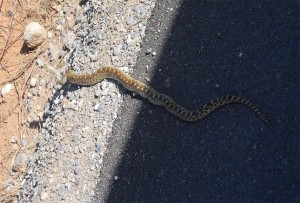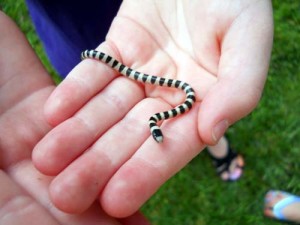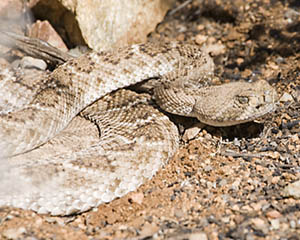Non-Venomous Snakes
Gopher Snake

The Gopher Snake is the largest snake in Arizona – it can reach lengths up to about eight feet long. They are a tannish cream color as you can see in the picture and are found in most of the state up to about 9000 feet above sea level. They hibernate in the winter but can be found anytime day or night when they are active. They will try to mimic a rattle snake if threatened by hissing, striking out and wiggling their tail very quickly. They are a non-venomous constrictor that helps reduce the high desert rodent population. If you come across a Gopher snake it’s best just to admire it and let it go about its business.
Groundsnakes

Groundsnakes can be found in several different color patterns and are often confused with coral and king snakes. They can reach lengths of about 19″ but the ones I see generally are about the same size as the one pictured. If you come across a groundsnake in your home it’s best just to get him into a dust pan and place it back outside. They prey mainly on insects so having them around the house is like having an organic pest control technician on staff. This snake can be found day or night in the right conditions and generally is dormant during the winter months.
Sonoran Mountain Kingsnake
Also known as the Arizona Mountain Kingsnake, the Sonoran Mountain Kingsnake coloration is similar to the Groundsnake and the venomous Sonoran Coral Snake.
Venomous Snakes

Occasionally here in the high desert, we will see a rattlesnake. Rattlesnakes are poisonous and contact should be avoided. In most case, they’ll warn you with their rattle if they are aware of you moving towards them, although young rattlers may not have a rattle. It’s most common to run across rattlesnakes when doing simple yard clean up in the back yard. It’s also possible to find a venomous Coral Snake in Arizona, though very uncommon.
The two main things a rattlesnake is seeking most of the time is food and shelter. When you get rid of shelter for the snake or their food source – rodents – you’ll have less likely chance of a close encounter. Get rid of garbage, wood piles, tall weeds, and brush piles that snakes and rodents could live in. Fill in gopher holes in the yard or around the building foundation. Wood decks that are close to the ground should be sealed around the perimeter to keep snakes and other pests like rodents and skunks from hiding under there.
The three most common rattlesnakes that I have come across over the years are the Western Diamondback Rattlesnake, the Black-Tailed Rattlesnake, and the Mohave Rattlesnake.

Western Diamond-Backed Rattlesnake
The Western Diamond-Backed Rattlesnake is primarily active from dawn to twilight in Spring and Fall. During the hotter summer months it is mostly active at night and near dawn or twilight. In most cases, they’ll then retreat toward shelter.
Black-Tailed Rattlesnake
The Black-Tailed Rattlesnake can be active at any time of day when conditions are right. Like the Diamond-Backed Rattlesnake, it’s active from dawn to twilight in Spring and Fall. During the hotter summer months it is mostly active at night and near dawn or twilight. This snake is often quick to rattle at the first hint of danger, which often gives away its presence.
Mohave Rattlesnake
The Mohave Rattlesnakes is mostly active at night and in the hours near dawn and twilight. This rattlesnake puts on a more dramatic show when it feels itself in danger – it moves its head into a striking position and rattles incessantly, and will even make striking motions. Gradually, it will retreat for shelter.
Western Coral Snake
The Western Coral Snake is a venomous snake that is very rare, but more likely to be found in Southern Arizona. It usually only reaches about two feet long, and it has a small mouth which makes it difficult to bite a human. Unlike the rattlesnakes, a Coral Snake has short teeth and has to chew on its victim to inject its venom. It’s coloration is similar to a the Arizona Mountain Kingsnake, which is what you’re most likely to see in the Verde Valley and Prescott Valley. See the Snakes of Arizona web page to compare the banding of the Kingsnake and the Coral Snake.
